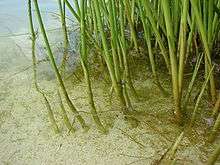Cyperus laevigatus
Cyperus laevigatus is a species of sedge known by the common name smooth flatsedge.
| Smooth flatsedge | |
|---|---|
 | |
| Scientific classification | |
| Kingdom: | Plantae |
| Clade: | Tracheophytes |
| Clade: | Angiosperms |
| Clade: | Monocots |
| Clade: | Commelinids |
| Order: | Poales |
| Family: | Cyperaceae |
| Genus: | Cyperus |
| Species: | C. laevigatus |
| Binomial name | |
| Cyperus laevigatus | |

Distribution
Cyperus laevigatus is grows in wet areas, especially in brackish water, wet alkaline soils, mineral-rich hot springs, and other moist saline and alkaline habitat. It is known from the beaches of the Hawaiian Islands and salty pools in the deserts of the Southwestern United States (California, Arizona, Texas) down through Mexico and Central America to South America. It is also widespread across most of the West Indies, Africa, the Mediterranean Basin, the Middle East, India, Central Asia, Australia and various oceanic islands.[1][2][3][4][5][6][7]
Description
Cyperus laevigatusis a perennial sedge growing up to 60 centimeters tall, sometimes in clumps interconnected on a horizontal rhizome. The inflorescence is a small array of cylindrical spikelets with one to three leaflike bracts at the base. The spikelets vary in color from green to reddish to dark brown.
History
In Hawai'i, Cyperus laevigatus is known as makaloa and was used by the people of Ni'ihau to make beautiful plaited mats. Many of the finest examples of plaiting in Hawai'i are made from makaloa.[8]
Ecology
The caterpillars of the tiny moth Chedra microstigma have been found to mine within the leaves of this host plant in coastal marsh in Oahu.[9][10]
References
- Kew World Checklist of Selected Plant Families
- Flora of North America
- Acevedo-Rodríguez, P. & Strong, M.T. (2005). Monocotyledons and Gymnosperms of Puerto Rico and the Virgin Islands. Contributions from the United States National Herbarium 52: 1-415.
- Govaerts, R. & Simpson, D.A. (2007). World Checklist of Cyperaceae. Sedges: 1-765. The Board of Trustees of the Royal Botanic Gardens, Kew.
- Dobignard, D. & Chatelain, C. (2010). Index synonymique de la flore d'Afrique du nord 1: 1-455. Éditions des conservatoire et jardin botaniques, Genève.
- Hoenselaar, K., Verdcourt, B. & Beentje, H. (2010). Cyperaceae. Flora of Tropical East Africa: 1-466.
- Lambdon, P. (2012). Flowering plants & ferns of St Helena: 1-624. Pisces publications for St Helena nature conservation group.
- Hawaiian Ethnobotany Archived 2007-07-02 at the Wayback Machine
- Busck, August (1914). "New Microlepidoptera from Hawaii". Insecutor Inscitiae Menstruus. 2 (7): 106.
- Zimmerman, Elwood C. (1978). Insects of Hawaii (PDF). 9 Microlepidoptera. Honolulu: The University Press of Hawaii. pp. 1003–1015.
External links
| Wikimedia Commons has media related to Cyperus laevigatus. |
- Jepson Manual Treatment - Cyperus laevigatus
- USDA Plants Profile: Cyperus laevigatus
- Cyperus laevigatus - U.C. Photo gallery